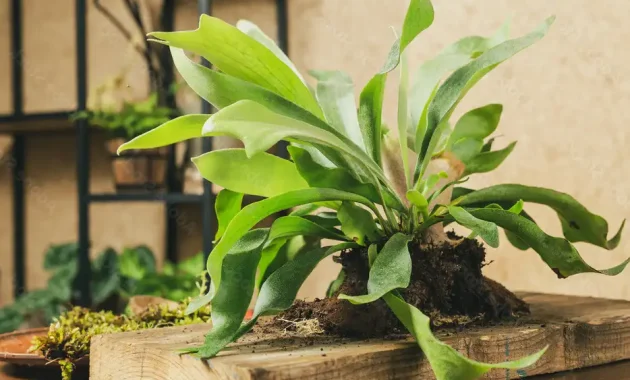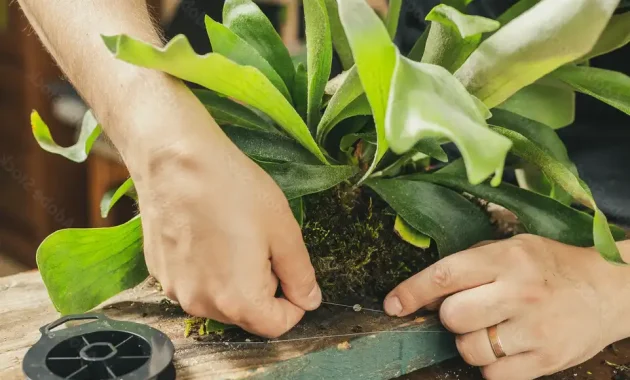Are you worried about your staghorn fern’s health? If you notice that it’s wilting, losing leaves, or turning black, it may be dying. But don’t give up hope just yet! With proper care and attention, you can revive your staghorn fern and bring it back to life.
First, it’s important to identify the problem. Staghorn ferns are vulnerable to stress, disease, and death, especially if they are not given the right conditions to grow. Overwatering, pest infestations, and direct sunlight are common problems that staghorn ferns face.
By understanding the root cause of your staghorn fern’s decline, you can take the necessary steps to save it. Keep reading to learn how to revive your staghorn fern and maintain its health for years to come.
Key Takeaways
- Signs of a dying staghorn fern include wilting, drooping, shedding leaves, and discolored patches.
- Causes of problems include overwatering (root rot) and underwatering, and excessive light can also harm the plant.
- To revive a dying staghorn fern, check watering, boost nutrients, reduce direct light, check for pests, cut back wilted leaves, and increase humidity.
- Staghorn ferns are vulnerable to stress, disease, and death without proper conditions, and common problems include brown leaves, brown tips, dropping leaves, root rot, excessive dryness, and stem turning black.
Identifying the Problem
If your staghorn fern is wilting or shedding leaves, it’s important to identify the problem quickly like a detective on a case.
One possible cause could be root suffocation, which occurs when the roots are not getting enough air or are being suffocated by compacted soil. This can lead to wilting, yellowing, and dropping of leaves.
Another potential cause of problems could be excessive light, as staghorn ferns prefer diffused light and can become stressed or damaged in direct sunlight.
Discoloration of the stem or fronds could be a sign of Rhizoctonia disease, which is caused by excessive moisture and can turn the stem black.
Pest infestations, such as aphids or mealybugs, can also harm staghorn ferns and cause wilting or discoloration. It’s important to carefully examine your plant and its growing conditions to pinpoint the cause of the problem and take appropriate action.
Watering Schedule
Proper watering is key to ensuring the health of your staghorn fern. Monitoring moisture levels is crucial to prevent both overwatering and underwatering. Overwatering can lead to root rot, which is a common cause of staghorn fern death. Underwatering, on the other hand, can cause the plant to wilt and shed leaves.
To prevent underwatering, make sure to water your staghorn fern regularly. In the growing season, watering once a week is recommended. However, during dormancy, watering every 2-3 weeks is sufficient. It is important to wait until the soil is slightly wilted before watering to avoid overwatering. Additionally, misting or using a humidifier can help maintain optimal humidity levels for your staghorn fern. To prevent overwatering, make sure to use a well-draining substrate and avoid leaving excess water in the pot or tray. The table below summarizes the watering schedule for staghorn ferns:
| Season | Watering Frequency |
|---|---|
| Growing | Once a week |
| Dormancy | Every 2-3 weeks |
Keeping a consistent watering schedule and monitoring moisture levels can go a long way in preventing staghorn fern problems and maintaining the health of your plant.
Reviving Techniques
Reviving a struggling staghorn fern is possible by checking its watering frequency. Over- or underwatering can cause wilting or shedding leaves. Make sure to water the plant only when the top layer of the growing substrate is slightly dry to the touch.
You can also boost the plant’s nutrient intake by adding slow-release fertilizer or homemade compost to its substrate. Reducing direct light exposure can help revive a dying staghorn fern. These plants prefer diffused light and partial shade, so move them away from direct sunlight or use sheer curtains to filter the light.
Checking for pest infestations and using natural pest control methods, such as neem oil, can also help the plant recover. Increasing humidity levels by misting or using a humidifier can prevent the plant from drying out and encourage new growth.

Pest Management
Congratulations! Your beautiful staghorn fern has become a haven for pesky insects, who are now feasting on its leaves and draining its life force. It’s important to take action immediately to prevent further damage and save your plant.
Here are some tips for managing pests on your staghorn fern:
- Identify the type of insect infesting your plant. This will help you choose the right natural remedies to get rid of them. Common pests that attack staghorn ferns include aphids, mealybugs, and spider mites.
- Use organic solutions to avoid harming your plant with chemicals. Neem oil is an effective natural remedy that can be applied to the leaves and stems of your staghorn fern to deter pests. You can also use homemade solutions made from garlic, onion, or chrysanthemum.
- Prevention is key to avoiding pest infestations in the first place. Keep your staghorn fern in a clean environment and avoid overwatering, which can attract insects.
- Regularly inspect your plant for signs of infestation and take action immediately to prevent further damage. Removing infected leaves and isolating your plant can also help prevent the spread of pests to other plants in your home.
By following these pest management tips and using natural remedies, you can help save your dying staghorn fern and keep it healthy for years to come.
Maintenance and Care Tips
To keep your beloved staghorn fern healthy and thriving, it’s important to regularly maintain and care for it with these easy tips. First, make sure to prune your fern properly. Remove any dead or damaged fertile fronds, but leave the basal fronds to decompose. This will provide nutrients for the fern and help it grow. Additionally, trimming aged fronds can also invigorate the base and promote new growth.
Next, humidity control is crucial for the health of your staghorn fern. These plants love medium to high humidity, so consider investing in a humidifier or misting the plant regularly. You can also place a tray filled with water underneath the pot to keep it hydrated. Potting options are important as well. Select a pot with enough drainage, and use a substrate consisting of perlite, sphagnum moss, and charcoal. Finally, fertilization methods should be considered. Use slow-release fertilizer or opt for homemade compost to promote growth. And remember, always monitor your plant’s behavior to spot any issues early on.
| Pruning Techniques | Humidity Control | Potting Options |
|---|---|---|
| Remove dead/damaged fertile fronds | Invest in a humidifier or mist the plant regularly | Select a pot with enough drainage |
| Leave basal fronds to decompose | Place a tray filled with water underneath the pot to keep it hydrated | Use a substrate consisting of perlite, sphagnum moss, and charcoal |
| Trim aged fronds to invigorate base | Monitor plant behavior to spot issues early |
| Light Exposure | Fertilization Methods | |
|---|---|---|
| Loves diffused light and partial shade | Use slow-release fertilizer or opt for homemade compost | |
| Do not provide direct sunlight | Feed with fertilizer every 2 months | |
| Bright and indirect sunlight is ideal |
FAQs about How To Save A Dying Staghorn Fern
Can staghorn ferns be grown outdoors or are they strictly indoor plants?
Staghorn ferns can thrive outdoors or indoors, but they require specific growing conditions. Provide partial shade, high humidity, and well-draining soil. Prune dead fronds and try creative displays like hanging baskets or mounting on driftwood.
How long does it take for a staghorn fern to grow to maturity?
Staghorn ferns take years to reach maturity. Prune aged fronds to invigorate the base. They need diffused light, medium to high humidity, and weekly watering. Common pests include aphids and mealybugs.
What is the best way to propagate staghorn ferns?
To propagate staghorn ferns, use spores or divide the plant. Container options include baskets or mounting on a board or tree. Prune to invigorate the base. Watering needs are same as mature plants. Light requirements are bright, indirect light.
Are there any specific diseases that staghorn ferns are particularly susceptible to?
Staghorn ferns are susceptible to fungal infections, pest infestations, nutrient deficiencies, watering issues, and environmental stress. Black spots on fronds at the base indicate fungal infection and root rot is caused by overwatering.
Can staghorn ferns be grown in soil or do they require a different type of substrate?
Staghorn ferns can be grown in soil, but they prefer growing mediums such as sphagnum moss or coconut coir. The watering frequency, fertilization methods, and potting techniques should be adjusted according to their light requirements.


